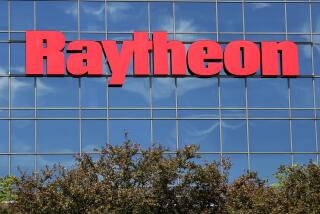Pentagon Buying of Equipment for Contractors Up 60%
- Share via
WASHINGTON — Fifteen years ago, the Pentagon ordered a phase-out of the government practice of furnishing equipment to defense contractors except in cases of national emergency or military mobilization.
Since then, federal investigators said Thursday, the value of government-owned equipment turned over free of charge to contractors has increased 60%--from $5.3 billion to $8.4 billion--and now includes such items as a $1,500 potato peeler and two $30,000 dishwashers given to General Dynamics Corp. for a company cafeteria.
According to officials of the General Accounting Office, the practice has resulted in contractors’ getting scores of desks, pickup trucks, millions of dollars in computer equipment--plus $15 wallets and $1,400 worth of “food trays” that turned out to be “trays of food catered for luncheon meetings.”
Sputters of Outrage
The GAO’s disclosures brought sputters of outrage from Rep. Jack Brooks (D-Tex.), chairman of the House Government Operations Committee, and the embarrassed acknowledgment of a Pentagon official that “we are not satisfied with our progress” in implementing the 1971 policy.
After receiving the GAO report, Brooks called a panel of middle-level Defense Department officials before his committee Thursday and lectured them for “giving away blank checks” to some of the nation’s largest defense contractors. The government-furnished equipment is being “dissipated like free beer. . . . It’s gone and I bet you won’t recover 2 cents on every dollar,” Brooks said.
After the hearing, Brooks said that Defense Secretary Caspar W. Weinberger should “get off his duff” and correct the latest in the long-running litany of contractor abuses. “He’s got to get after it with more urgency,” Brooks said in an interview. “When you are trying to spend $300 billion a year, you had better pay attention. . . . Waste is not just one big thing, it’s a thousand little things.”
Estimate May Be Too Low
Frank C. Conahan, director of the GAO’s national security and international affairs division, said the $8.4-billion estimate for government-furnished equipment in possession of contractors may be too low. He told the Brooks committee that neither the Defense Department nor the military services has “central accountability or visibility over how much . . . is acquired annually, how it is being used or how much is being discarded.”
The practice dates back to World War II, when “contractors were unable or unwilling to make the huge investments required for mobilization,” Conahan said. It continued through the Korean War but, in 1970, the Pentagon told the services to come up with plans for a five-year phase-out. This was reinforced with a set of directives declaring that government-owned equipment would be furnished contractors only to meet “surge and mobilization requirements.”
But Conahan said the policies “have not been effectively implemented.” He cited scores of examples found by GAO auditors when they examined 25 contractors, large and small. They included:
--$100,000 worth of kitchen equipment for the cafeteria at the government-owned, contractor-operated plant in Fort Worth, Tex., where General Dynamics produces F-16 fighter aircraft. The items included the $1,500 potato peeler, a $2,400 food cutter and two dishwashers costing a total of $60,000 and were purchased under a clause in the General Dynamics contract allowing “replacement of equipment.”
Equipment ‘Not Critical’
Conahan said the kitchen equipment “does not appear critical to the mission of the facility.” Ira Kemp, associate director for contracting and manufacturing policy, said in response to Brooks’ questions that “I do not know the specifics of the potato peeler.”
--$875,000 worth of office furniture and computer equipment for URS-Berger Service Co., a firm that prepares environmental impact statements for the Air Force’s Ballistic Missile Office at Norton Air Force Base in California. These included a $1,300 conference table, three $1,000 oak desks and 13 bookcases that cost $600 each.
“The rationale for the authorization was that the Air Force needed to have the contractor near the program office and the contractor was unwilling to provide the equipment,” the GAO report said.
‘Practice Is Widespread’
--At a Rockwell Corp. plant in Palmdale, Calif., the contractor for the B-1 bomber program purchased at government expense 24 vehicles costing $630,000 “and added a 14% profit, or about $88,000, to that total,” Conahan said. “Air Force contract management division officials provided us with documentation showing that such practice is widespread.”
--A $142,000 computer purchased at government expense by National Data Corp. of Rockville, Md., “was used for only half a year before the DOD told the contractor to replace it with another computer,” he testified. The computer has been in storage more than a year, “awaiting disposition instructions.”
More to Read
Sign up for Essential California
The most important California stories and recommendations in your inbox every morning.
You may occasionally receive promotional content from the Los Angeles Times.













